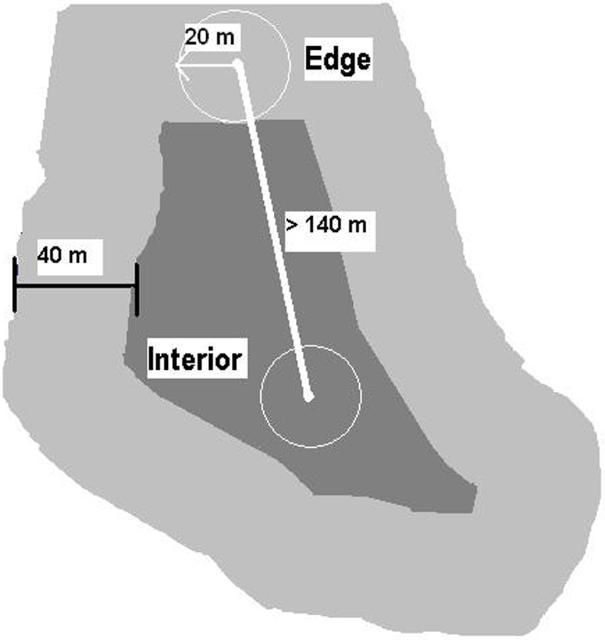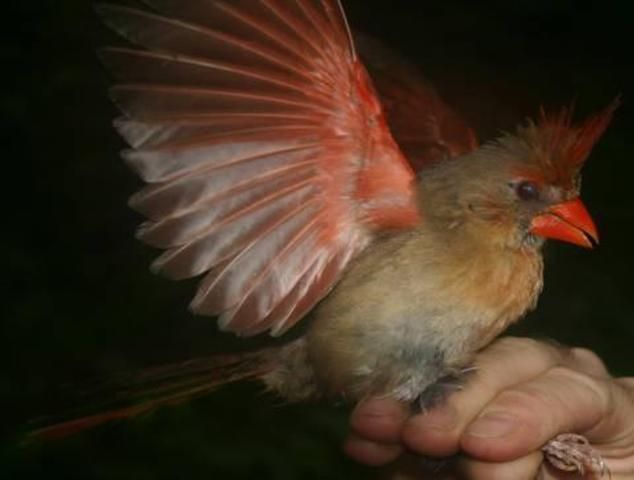Introduction
The human environment is usually dominated by the trappings of urban life: buildings, roads, cars, lights, signs, and of course, people, all of which are surrounded by a cacophony of noises. Within this environment of concrete, metal and glass, wildlife have little habitat (food, water, space, shelter) unless they can tolerate and/or prefer the high levels of disturbance. It is no wonder, then, that when we consider urban birds, usually the most visible wildlife, most people generally think of non-native, conspicuous, and abundant species like the Rock Dove (Columba livia), House Sparrow (Passer domesticus) and the Common Starling (Sturnus vulgaris). The notion that bird diversity is limited to few species in urban areas might discourage people from attempting to conserve or observe wildlife in these settings. Interest in bird-watching and wildlife observation is increasing nationwide, and the urban environment is an overlooked, convenient place for birdwatchers and nature enthusiasts. Forest remnants within the urban environment are important wildlife habitat with the potential to conserve a high diversity of native birds. In order to create and maintain such urban bird habitats, one needs to understand more about urban forest remnant design and management. Below, we discuss urban forest remnant design and management as it relates to bird conservation.
Urban Forest Remnants
Urban forest remnants are diverse in shape, size, and composition, and take the form of parks, wooded buffers, greenways and conservation-oriented natural areas. Due to their locations and competition with building space, many remnants tend to be small, and have high edge to interior ratios; that is, they are longer than they are wide with more edge than interior space (Figure 1). Compared to interior habitats, edge habitats generally experience higher levels of disturbance from wind, greater exposure to sunlight, and higher temperatures. In Florida, this often leaves under- and mid-story remnants dominated by hardy, fast growing vines and shrubs such as greenbriar (Smilax sp.) and blackberry (Rubus sp.), and saplings of a few overstory tree species. Depending on the forest remnant, edge characteristics can extend into a patch more than 300 feet. Because forest remnants are generally fragments of the forest habitats that previously dominated the area, the overstories of urban remnants often contain large, mature trees (e.g. live oak, or Quercus virginiaus and sweet gum, or Liquidambar stryaciflua). Remnants are often home to many introduced invasive plant species such as air potato (Dioscorea bulbifera), coral ardesia (Ardesia crenata), and various species of non-indigenous privet (Ligustrum sp.). A typical urban forest remnant edge in north Florida is seen in Figure 2.

Credit: Dan Dawson

Credit: Dan Dawson
Wetlands can also make up significant portions of urban forest remnants. These urban wetlands may provide natural drainage areas for the surrounding development. Wetland areas generally are more difficult to develop than upland areas because of many local regulations. Though often small, these wetlands can contribute to the overall plant and animal diversity of a remnant.
Even though their sizes, shapes and locations often mean that forest remnants do not contain a functional "interior" habitat, the remaining habitat in such remnants may still provide cover from predators, foraging and breeding opportunities, and migration stop-over habitat. Moreover, such habitat can also act as a refuge from human disturbance for a variety of bird species. Remnants provide wonderful opportunities for observing a diverse variety of bird species in the urban environment. Urban birdwatchers should bear in mind that the occupation of urban forest remnants by birds depends upon remnant characteristics and the time of year.
Forest Remnant Characteristics that Influence Bird Diversity
Remnant Size: Generally, larger remnants tend to have more bird species than small remnants. This is because there is a higher diversity of habitat types (vegetation) within larger remnants.
Habitat diversity: Generally, greater diversity of vegetation structure will have more bird species due to more available niches than non-diverse patches. Niches are areas that contain food, water, and shelter in sufficient quantity to house a particular species.
Connectivity: Remnants that are closer to other remnants or larger intact habitats tend to have more species then remnants that are more isolated. This is due to the ability of birds from source habitats to find nearby patches of habitat.
Shape: Generally, remnants that are longer than they are wide tend to have fewer species than areas that are as long as they are wide. This is because many birds that are specialists, have narrower habitat niches and are generally more sensitive to human activity, and thus require more interior habitat. Generalists, such as northern cardinals (Cardinalis cardinalis), do well in edge habitat, whereas many neo-tropical warblers (e.g. hooded warblers Wilsonia citrine) avoid edge habitats for foraging or nesting.
The Influence of Season on Bird Diversity
Besides the physical and vegetative characteristics of remnants, season is the most significant factor influencing the presence of birds. Three main periods of the year, summer, winter, and fall and spring migration periods, influence the diversity of birds in urban areas. With each season, new combinations of bird species make use of urban forest remnants. Table 1 shows the species noted during each season of a year-long survey of birds conducted from 2004–2005 within 6 urban forests on the University of Florida campus in Gainesville, Florida. These remnants ranged from approximately 2 to 20 hectares in size.
Summer
During summer, most birds are engaging in courtship, breeding, nesting, and brooding activities. Many species have specific habitat requirements during breeding season. Most species that court and breed in urban forest remnants are generalists. They prefer edges or are edge-indifferent, and are generally area-insensitive (i.e., they can nest successfully in small or large forest patches). Such species are also tolerant of urban activities, including traffic noise.
Species that nest in urban forest remnants must deal with a range of impacts, including nest predation (from raccoons, feral cats, etc.), disturbance from humans, and the environmental challenges of edge-dominated habitat (higher temperatures, more wind, etc.). Some examples of breeding urban birds are northern cardinal (Cardinalis cardinalis) (Figure 3), northern mockingbird (Mimus polyglottis), and Carolina wren (Thryothorus ludovicianus). Because of the lack of suitable breeding and nesting habitats available for other, non-generalist species, the summer is usually the season of lowest bird diversity in urban forest remnants. In our point count surveys of forest remnants at the University of Florida, only 30 species were observed during the summer, out of a total of 66 for the year (Table 1).

Credit: Elizabeth Farley-Dawson
Winter
Winter bird communities are made up of year-round residents and winter residents. Winter residents are birds that are present during the winter months, but then migrate to their northern breeding grounds during the spring. Depending on the species, they arrive throughout the fall and early winter, and leave throughout the spring and early summer. During the winter months, overwintering birds are primarily seeking food resources and safety from predators. Many birds join single- or mixed-species flocks for these purposes. In north Florida, mixed flocks containing winter residence species, such as ruby-crowned kinglet (Regulus calendula) and palm warbler (Dendroica palmarum), are commonly found in urban forest remnants. Large flocks of American robins (Turdus migratorius) and cedar waxwings (Bombycilla cedrorum) can be seen foraging together within forest remnants. Unlike the breeding season, in winter many bird species have much more flexible habitat use patterns, and birds that will not breed in urban forest remnants might use them to forage or roost in during the winter. For example, in our surveys of UF forest remnants, ovenbirds (Seiurus aurocapillus) were found using the edge of a small urban patch during the winter. Ovenbirds are area sensitive and usually breed in mature, large patches of forests. In our UF survey, 43 of 66 detected species were observed in forested patches during the winter season (Table 1).
Fall/Spring Migration
During the fall/spring migration, the bird community includes year-round residents, winter residents that are either preparing to leave (in the spring, mostly March–April) or arriving (in the fall, mostly September–October), and various species of neotropical migrants (birds that winter in tropical America and breed in temperate America). These migrating species utilize urban forest remnants as stop-over habitat on their way to or from breeding and wintering grounds. They can only be seen in Florida for several weeks during the fall and spring. The priorities of many birds during migration periods are finding food and safety from predators as they move to or from their breeding grounds, though year-round residents are also beginning their breeding activities during the spring. During the spring and fall, a variety of migrants may be found within an urban remnant, depending on the migration route a particular species takes. For instance, blackpoll warblers (Dendroica striata) use the Florida peninsula more in the spring migration than in the fall, and magnolia warblers (Dendroica magnolia) follow the opposite pattern. Species such as prairie warbler (Dendroica discolor) and American redstart (Setophaga ruticilla) are commonly seen in urban forest areas in north Florida during both the fall and the spring. The timing of migration of stop-over and winter migrants varies, with different species arriving and leaving at different times. All this means that the spring and fall migration seasons are often the best times to observe urban birds, as the chances of observing new, different, and uncommon migrant species are greater. The birding experience during the spring and fall will change every day. In the UF survey, an overall sum of 55 species was detected during the spring and fall migration periods, with 39 species in the spring and 42 species in the fall (Table 1).
A Note on Stop-Over Migrants
The extent to which stop-over neo-tropical migrants use urban forest remnants in Florida is largely unknown, though two previous studies in Gainesville have shown that a few species are sighted in urban remnants (Dawson and Hostetler 2010; Hostetler et al. 2005). However, due to declining available habitat because of human development, urban forest remnants may be increasingly important stop-over habitats for a variety of birds.
Conclusion
Urban forest remnants can contain habitat for birds and can be likely places in which to view a variety of bird species. For developers and planners, taking into account the characteristics of forest remnants that influence the diversity of birds (as well as other taxa) can potentially result in more urban bird habitat. For wildlife observers and "birders," urban forests can be good spots in which to view and enjoy a variety of bird life. Urban forests should not be considered "unimportant" bird habitat; instead they should be valued and conserved for future generations of both birds and humans.
Additional Resources
Books and Scientific Publications
Dawson, D., and M. Hostetler. 2010. Edge avoidance by birds within urban forest remnants. Florida Scientist. (IN PRESS).
Hostetler, M., D. Scot, and J. Paul. 2005. Post-construction effects on an urban development on migrating, resident, and wintering birds. Southeast. Nat. 4:421–434.
Chace, J. F., and J. J. Walsh. 2006. Urban effects on native avifauna: a review. Landscape and Urban Planning. 74:46–69.
Online
Hostetler, M. E., G. Klowden, S. Webb, S. W. Miller, and K. N. Youngentob. 2003. Landscaping backyards for wildlife: top ten tips for success. https://edis.ifas.ufl.edu/publication/UW175
Florida Fish and Wildlife Conservation Commission—Planting a Refuge for Wildlife: https://myfwc.com/viewing/habitat/refuge/
Living Green: https://livinggreen.ifas.ufl.edu/
Program for Resource Efficient Communities: https://edis.ifas.ufl.edu/publication/UW247
For more information: https://buildgreen.ifas.ufl.edu/
Species, residency status, presence for all bird species observed per season during point count surveys conducted on Conservation Areas of the University of Florida campus from 2004–2005. Residency codes: WM=winter migrant, SM=summer migrant, SO = stopover migrants and YR=year-round residents. "X" indicates it was present during that season.